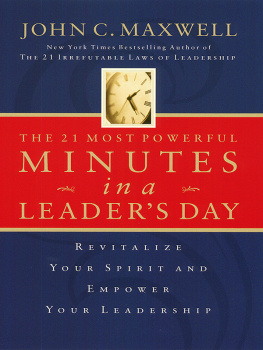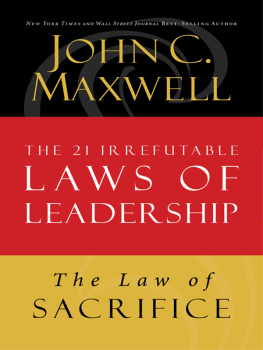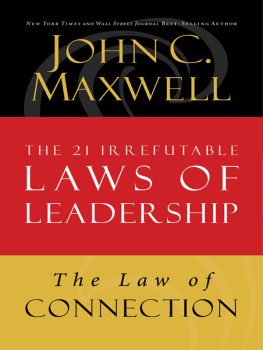John C. Maxwell - The Law of the Lid: Lesson 1 from the 21 Irrefutable Laws of Leadership
Here you can read online John C. Maxwell - The Law of the Lid: Lesson 1 from the 21 Irrefutable Laws of Leadership full text of the book (entire story) in english for free. Download pdf and epub, get meaning, cover and reviews about this ebook. year: 2012, publisher: Harpercollins Leadership, genre: Business. Description of the work, (preface) as well as reviews are available. Best literature library LitArk.com created for fans of good reading and offers a wide selection of genres:
Romance novel
Science fiction
Adventure
Detective
Science
History
Home and family
Prose
Art
Politics
Computer
Non-fiction
Religion
Business
Children
Humor
Choose a favorite category and find really read worthwhile books. Enjoy immersion in the world of imagination, feel the emotions of the characters or learn something new for yourself, make an fascinating discovery.
- Book:The Law of the Lid: Lesson 1 from the 21 Irrefutable Laws of Leadership
- Author:
- Publisher:Harpercollins Leadership
- Genre:
- Year:2012
- Rating:3 / 5
- Favourites:Add to favourites
- Your mark:
- 60
- 1
- 2
- 3
- 4
- 5
The Law of the Lid: Lesson 1 from the 21 Irrefutable Laws of Leadership: summary, description and annotation
We offer to read an annotation, description, summary or preface (depends on what the author of the book "The Law of the Lid: Lesson 1 from the 21 Irrefutable Laws of Leadership" wrote himself). If you haven't found the necessary information about the book — write in the comments, we will try to find it.
Brothers Dick and Maurice MacDonald came as close as they could to living the American Dream, without making it. Instead a guy named Ray Kroc did it with the company they had founded. It happened because they didnt know the Law of the Lid.
John C. Maxwell: author's other books
Who wrote The Law of the Lid: Lesson 1 from the 21 Irrefutable Laws of Leadership? Find out the surname, the name of the author of the book and a list of all author's works by series.
The Law of the Lid: Lesson 1 from the 21 Irrefutable Laws of Leadership — read online for free the complete book (whole text) full work
Below is the text of the book, divided by pages. System saving the place of the last page read, allows you to conveniently read the book "The Law of the Lid: Lesson 1 from the 21 Irrefutable Laws of Leadership" online for free, without having to search again every time where you left off. Put a bookmark, and you can go to the page where you finished reading at any time.
Font size:
Interval:
Bookmark:

1998 and 2007 by John C. Maxwell
This ebook is derived from The 21 Irrefutable Laws of Leadership, by John Maxwell, 1998 and 2007 by Maxwell Motivation, Inc., a Georgia corporation.
All rights reserved. No portion of this book may be reproduced, stored in a retrieval system, or transmitted in any form or by any meanselectronic, mechanical, photocopy, recording, scanning, or otherexcept for brief quotations in critical reviews or articles, without the prior written permission of the publisher.
Published in Nashville, Tennessee, by Thomas Nelson. Thomas Nelson is a trademark of Thomas Nelson, Inc.
Thomas Nelson, Inc. titles may be purchased in bulk for educational, business, fund-raising, or sales promotional use. For information, please e-mail SpecialMarkets@ThomasNelson.com.
Published in association with Yates & Yates, LLP, Attorneys and Counselors, Orange, California.
Scripture quotations noted CEV are from THE CONTEMPORARY ENGLISH VERSION.
1991 by the American Bible Society. Used by permission.
Scripture quotations noted The Message are from The Message: The New Testament in Contemporary English. 1993 by Eugene H. Peterson.
ISBN 978-0-7852-7431-5 (HC)
ISBN 978-1-4185-3831-6 (ebook)
ISBN 978-1-4002-7560-1 (ebook of Chapter 1)

This book is dedicated to Charlie Wetzel, my writing partner since 1994. Together weve written more than forty books, and Ive enjoyed our collaboration on every one. As I have labored to add value to others by identifying and teaching leadership principles, Charlie, you have added value to me and my efforts. Your insights and skills as a wordsmith have been enjoyed by millions of readers. As a result, you have made a greater impact on more people than has anyone else in my inner circle. For that I thank you.
CONTENTS


Thank you to the thousands of leaders around the world who learned and sometimes challenged the laws of leadership, thus sharpening my thinking.
Thank you to the team at Thomas Nelson who gave me the chance to revise and improve this book, and especially to Tami Heim for her strategic leadership and to Victor Oliver who was instrumental in the development of the original concept.
Thank you to Linda Eggers, my executive assistant, and her assistant, Sue Caldwell, for their incredible service and willingness to go the extra mile every day.
Thank you to Charlie Wetzel, my writer, and Stephanie, his wife, with-out whose work this book would not have been possible.

Leadership Ability Determines
a Persons Level of Effectiveness
I often open my leadership conferences by explaining the Law of the Lid because it helps people understand the value of leadership. If you can get a handle on this law, you will see the incredible impact of leadership on every aspect of life. So here it is: leadership ability is the lid that determines a persons level of effectiveness. The lower an individuals ability to lead, the lower the lid on his potential. The higher the individuals ability to lead, the higher the lid on his potential. To give you an example, if your leadership rates an 8, then your effectiveness can never be greater than a 7. If your leadership is only a 4, then your effectiveness will be no higher than a 3. Your leadership abilityfor better or for worsealways determines your effectiveness and the potential impact of your organization.
Let me tell you a story that illustrates the Law of the Lid. In 1930, two young brothers named Dick and Maurice moved from New Hampshire to California in search of the American Dream. They had just gotten out of high school, and they saw few opportunities back home. So they headed straight for Hollywood where they eventually found jobs on a movie studio set.
After a while, their entrepreneurial spirit and interest in the entertainment industry prompted them to open a theater in Glendale, a town about five miles northeast of Hollywood. But despite all their efforts, the brothers just couldnt make the business profitable. In the four years they ran the theater, they werent able to consistently generate enough money to pay the one hundred dollars a month rent that their landlord required.
A NEW OPPORTUNITY
The brothers desire for success was strong, so they kept looking for better business opportunities. In 1937, they finally struck on something that worked. They opened a small drive-in restaurant in Pasadena, located just east of Glendale. People in Southern California had become very dependent on their cars, and the culture was changing to accommodate that, including its businesses.
The drive-in restaurant was a phenomenon that sprang up in the early thirties, and it was becoming very popular. Rather than being invited into a dining room to eat, customers would drive into a parking lot around a small restaurant, place their orders with carhops, and receive their food on trays right in their cars. The food was served on china plates complete with glassware and metal utensils. It was a timely idea in a society that was becoming faster paced and increasingly mobile.
Dick and Maurices tiny drive-in restaurant was a great success, and in 1940, they decided to move the operation to San Bernardino, a working-class boomtown fifty miles east of Los Angeles. They built a larger facility and expanded their menu from hot dogs, fries, and shakes to include barbecued beef and pork sandwiches, hamburgers, and other items. Their business exploded. Annual sales reached $200,000, and the brothers found themselves splitting $50,000 in profits every yeara sum that put them in the towns financial elite.
In 1948, their intuition told them that times were changing, and they made modifications to their restaurant business. They eliminated the carhops and started serving only walk-up customers. And they also streamlined everything. They reduced their menu and focused on selling hamburgers. They eliminated plates, glassware, and metal utensils, switching to paper and plastic products instead. They reduced their costs and lowered the prices they charged customers. They also created what they called the Speedy Service System. Their kitchen became like an assembly line, where each employee focused on service with speed. The brothers goal was to fill each customers order in thirty seconds or less. And they succeeded. By the mid-1950s, annual revenue hit $350,000, and by then, Dick and Maurice split net profits of about $100,000 each year.
Who were these brothers? Back in those days, you could have found out by driving to their small restaurant on the corner of Fourteenth and E Streets in San Bernardino. On the front of the small octagonal building hung a neon sign that said simply McDonalds Hamburgers. Dick and Maurice McDonald had hit the great American jackpot, and the rest, as they say, is history, right? Wrong. The McDonalds never went any further because their weak leadership put a lid on their ability to succeed.
THE STORY BEHIND THE STORY
Its true that the McDonald brothers were financially secure. Theirs was one of the most profitable restaurant enterprises in the country, and they felt that they had a hard time spending all the money they made. Their genius was in customer service and kitchen organization. That talent led to the creation of a new system of food and beverage service. In fact, their talent was so widely known in food service circles that people started writing them and visiting from all over the country to learn more about their methods. At one point, they received as many as three hundred calls and letters every month.
Next pageFont size:
Interval:
Bookmark:
Similar books «The Law of the Lid: Lesson 1 from the 21 Irrefutable Laws of Leadership»
Look at similar books to The Law of the Lid: Lesson 1 from the 21 Irrefutable Laws of Leadership. We have selected literature similar in name and meaning in the hope of providing readers with more options to find new, interesting, not yet read works.
Discussion, reviews of the book The Law of the Lid: Lesson 1 from the 21 Irrefutable Laws of Leadership and just readers' own opinions. Leave your comments, write what you think about the work, its meaning or the main characters. Specify what exactly you liked and what you didn't like, and why you think so.



















